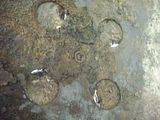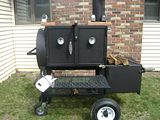Bob Bass
TVWBB Emerald Member
Peter,
Interesting discussion, ie Sous Vide cooking post BBQ segment. A couple of BBQ specific items to include. When BBQing, not only is that 'ingredient' Smoke added, so too is the bark, smoke ring (although not a flavor ingredient) and surface color. You could stop the BBQing of, let's say... a Beef Brisket... whole packer... 14 to 18 imperial pounds, at 3 or 4 hours. But you would lose some those other ingredients which fill out the BBQ equation. Bark is considered in some circle to equate to the quality of the BBQ. It is for sure a texture component. If you stop the cook before the bark is fully set, you would also lose some of that textural component.
Unlike most cuts, those used in 'traditional' BBQ can be of lower quality. This lower quality meat is more than likely muscle that is involve in the animal's locomotion. As such, both the contractile protein fibers and connective tissue fibers have developed themselves for that task, which also makes them more difficult to denature. Let's say you do the initial BBQ cook followed by the meat's removal from the BBQ around 160 degrees. When you move to the Sous Vide step, it wouldn't surprise me if you had to raise that temperature up into the 195-200 degree to finish the cook. Even with a long duration cook, you still need to fully denature those tough proteins, which tend to transform at higher than normal temperatures.
Interesting discussion, ie Sous Vide cooking post BBQ segment. A couple of BBQ specific items to include. When BBQing, not only is that 'ingredient' Smoke added, so too is the bark, smoke ring (although not a flavor ingredient) and surface color. You could stop the BBQing of, let's say... a Beef Brisket... whole packer... 14 to 18 imperial pounds, at 3 or 4 hours. But you would lose some those other ingredients which fill out the BBQ equation. Bark is considered in some circle to equate to the quality of the BBQ. It is for sure a texture component. If you stop the cook before the bark is fully set, you would also lose some of that textural component.
Unlike most cuts, those used in 'traditional' BBQ can be of lower quality. This lower quality meat is more than likely muscle that is involve in the animal's locomotion. As such, both the contractile protein fibers and connective tissue fibers have developed themselves for that task, which also makes them more difficult to denature. Let's say you do the initial BBQ cook followed by the meat's removal from the BBQ around 160 degrees. When you move to the Sous Vide step, it wouldn't surprise me if you had to raise that temperature up into the 195-200 degree to finish the cook. Even with a long duration cook, you still need to fully denature those tough proteins, which tend to transform at higher than normal temperatures.


